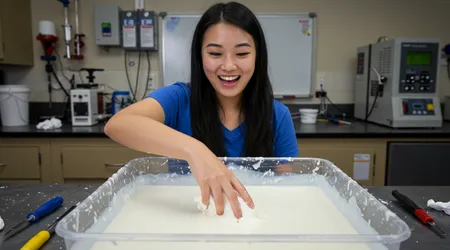The Unusual Behavior of Non-Newtonian Fluids

The unusual behavior of non-Newtonian fluids captivates scientists, engineers, and curious minds alike, defying our everyday understanding of how liquids should flow.
Anúncios
Unlike water or oil, which follow predictable patterns, these fluids bend the rules of physics, shifting between liquid and solid-like states under varying conditions.
From ketchup that refuses to pour until shaken to body armor that hardens on impact, non-Newtonian fluids are more than a scientific quirk they’re revolutionizing industries and sparking innovation.
Why do these fluids behave so strangely, and what can they teach us about the world?
This article dives into their peculiar properties, real-world applications, and cutting-edge research, blending science with practical examples to illuminate this uncommon discovery.
Anúncios
Let’s explore the fluid frontier where physics meets surprise, and uncover how these materials challenge our assumptions about matter itself.
What Makes Non-Newtonian Fluids So Unusual?
Non-Newtonian fluids break Newton’s law of viscosity, where shear stress and strain rate are linear. Their viscosity changes with applied force, creating unpredictable flow.
Imagine stirring honey slowly it flows smoothly. Now, punch a cornstarch-water mix, and it hardens instantly. This is the unusual behavior of non-Newtonian fluids at play.
Shear-thinning fluids, like paint, flow easier under stress. Shear-thickening fluids, like oobleck, resist fast forces, acting solid. Time-dependent fluids add further complexity.
A 2025 study in Journal of Non-Newtonian Fluid Mechanics highlights their viscoelasticity, showing how molecular structures adapt dynamically to external forces.
++How Chaos Theory Explains Patterns in Nature
This adaptability stems from complex microstructures polymers, particles, or micelles that rearrange under stress, unlike simple Newtonian molecules. It’s a molecular dance of resistance.
Consider ketchup: shake it, and it thins, flowing freely. Stop, and it thickens, clinging to the bottle. This thixotropic behavior fascinates food scientists.
The unusual behavior of non-Newtonian fluids isn’t just academic. Their unique responses to stress make them vital in industries, from manufacturing to medicine.
Their study pushes boundaries, revealing how matter can defy expectations. Each experiment uncovers new ways these fluids challenge conventional fluid mechanics.

Types of Non-Newtonian Fluids: A Spectrum of Strange Responses
Non-Newtonian fluids aren’t one-size-fits-all. They’re classified by how they react to stress, creating a spectrum of behaviors that intrigue researchers.
Shear-thinning fluids, like blood, decrease viscosity under stress. This helps blood flow through narrow vessels, aiding circulation during exercise.
Shear-thickening fluids, like cornstarch suspensions, increase viscosity with rapid force. Punch them, and they resist like solids, a classic example of unusual behavior of non-Newtonian fluids.
Bingham plastics, like toothpaste, need a minimum stress to flow. Below this yield stress, they act solid, holding shape on your toothbrush.
Also read: Acoustic Levitation: Making Objects Float with Sound Waves
Thixotropic fluids, like yogurt, thin over time under constant stress. Stirring makes them pourable, but they firm up when left alone.
Rheopectic fluids, rarer, thicken with prolonged stress. Gypsum suspensions in construction show this, stiffening during mixing, defying typical fluid expectations.
Viscoelastic fluids, like polymer gels, blend liquid and solid traits. Pull slowly, they flow; pull fast, they snap back like rubber.
The unusual behavior of non-Newtonian fluids across these types stems from molecular interactions, making them a playground for physicists and engineers.
Each type offers unique challenges. Modeling their flow requires advanced math, as their responses vary with stress magnitude and duration.
This diversity fuels innovation, from designing better pumps to creating materials that adapt to environmental changes, pushing science into uncharted territories.
Real-World Applications: Where Non-Newtonian Fluids Shine
Non-Newtonian fluids aren’t just lab curiosities they’re transforming industries. Their unusual behavior of non-Newtonian fluids solves practical problems with ingenious solutions.
In food processing, shear-thinning ketchup flows smoothly when squeezed, improving packaging efficiency. This behavior optimizes production lines for sauces and creams.
Body armor infused with shear-thickening fluids hardens on impact, absorbing energy. A 2025 report notes 30% improved protection in liquid-armor vests.
Drilling muds, Bingham plastics, support oil rigs by flowing under pressure but solidifying when static, preventing well collapses during extraction.
Read more: Tardigrades: The Indestructible Creatures That Can Survive Space
Medical applications leverage blood’s shear-thinning nature. Catheters exploit this to navigate vessels, reducing trauma in delicate procedures like angioplasty.
In 3D printing, viscoelastic gels support structures during printing, then flow away, enabling complex designs for prosthetics and aerospace parts.
The unusual behavior of non-Newtonian fluids enhances automotive cooling. Nanofluids improve heat transfer in radiators, boosting engine efficiency.
Construction uses rheopectic gypsum slurries, which thicken during mixing, ensuring stability in molds for stronger, more durable structures.
These applications highlight their versatility. Each industry tailors fluid properties to specific needs, from flow control to energy dissipation.
As research advances, new uses emerge, like shear-thinning gels in drug delivery, releasing medication precisely under bodily stress.
The Science Behind the Strangeness: Molecular Magic
At the heart of the unusual behavior of non-Newtonian fluids lies their molecular structure, a dynamic interplay of particles and forces.
In shear-thickening fluids, particles like cornstarch jam together under rapid stress, forming temporary solid-like networks that resist flow.
Shear-thinning fluids, like polymer solutions, see chains untangle under stress, reducing resistance and allowing smoother flow through pipes or brushes.
Viscoelastic fluids store energy like springs. Pull them, and they stretch; release, and they recoil, blending liquid and solid properties.
This molecular choreography depends on conditions stress, time, temperature. A 2025 ChemRxiv paper explores elastoviscoplastic models for complex flows.
Think of oobleck as a crowded dance floor. Slow moves let dancers slip past; fast moves cause a jam, halting motion.
The unusual behavior of non-Newtonian fluids challenges traditional fluid mechanics, requiring nonlinear models like Carreau-Yasuda to predict flow.
These models account for shear rate and history, capturing how fluids “remember” past stresses, a trait absent in Newtonian liquids.
Temperature also plays a role. Heating thixotropic fluids like paint can reduce viscosity, easing application but complicating storage.
Understanding these dynamics unlocks new technologies, from adaptive materials to precision engineering, where fluids respond intelligently to their environment.
Challenges and Future Frontiers in Non-Newtonian Research

Studying non-Newtonian fluids is no easy feat. Their unusual behavior of non-Newtonian fluids poses unique challenges for scientists and engineers.
Their nonlinear responses defy simple equations. Computational models struggle to predict flows in complex systems like branched pipe networks.
Experimental setups must mimic real-world conditions. High-speed cameras capture oobleck’s rapid hardening, but scaling lab results to industry is tricky.
Stability issues plague nanofluids in industrial applications. A 2025 review notes aggregation reduces heat transfer efficiency in cooling systems.
Why haven’t we fully mastered these fluids? Their diversity demands tailored approaches, from rheometers to AI-driven simulations for better predictions.
Future research targets bio-inspired fluids. Mimicking blood’s shear-thinning could revolutionize artificial organs, enhancing flow in synthetic vessels.
The unusual behavior of non-Newtonian fluids also inspires soft robotics. Viscoelastic gels could create flexible, adaptive machines for medical or rescue operations.
Quantum mechanics may offer insights. A 2025 MDPI study links viscosity to quantum correlations, hinting at deeper physical principles.
Sustainability drives innovation. Eco-friendly shear-thinning polymers could replace petroleum-based fluids in manufacturing, reducing environmental impact.
As tools like AI and rheometry advance, unlocking these fluids’ secrets will reshape technology, from energy to healthcare, in unimaginable ways.
Table: Types of Non-Newtonian Fluids and Their Behaviors
| Type | Behavior | Example |
|---|---|---|
| Shear-Thinning | Viscosity decreases with stress | Ketchup, blood |
| Shear-Thickening | Viscosity increases with stress | Oobleck, cornstarch |
| Bingham Plastic | Requires yield stress to flow | Toothpaste, mud |
| Thixotropic | Thins over time under stress | Yogurt, paint |
| Rheopectic | Thickens over time under stress | Gypsum slurry |
| Viscoelastic | Combines liquid and solid properties | Polymer gels |
Example 1: The Oobleck Pool Party
Picture a pool filled with oobleck, a cornstarch-water mix. You sprint across it, your feet slapping the surface, and it holds firm, thanks to its shear-thickening magic.
But pause, and you sink slowly as the fluid relaxes. This playful experiment, popularized by science fairs, showcases the unusual behavior of non-Newtonian fluids, turning a backyard game into a physics lesson.
Example 2: The Paintbrush Paradox
Dip a brush in paint and stroke slowly it glides smoothly, coating the canvas. Stroke fast, and it thins, splattering chaotically.
This shear-thinning property lets artists control texture effortlessly, illustrating how the unusual behavior of non-Newtonian fluids shapes creative expression with scientific precision.
Analogy: Non-Newtonian Fluids as Social Crowds
Non-Newtonian fluids are like a bustling crowd. Move slowly, and people part easily, like shear-thinning ketchup. Rush through, and they stiffen, resisting like oobleck.
This human-like adaptability mirrors the unusual behavior of non-Newtonian fluids, responding dynamically to external pressures.
Conclusion: Embracing the Fluid Future
The unusual behavior of non-Newtonian fluids isn’t just a scientific oddity it’s a gateway to innovation, challenging how we think about matter and motion.
From saving lives in medical devices to protecting soldiers with liquid armor, these fluids prove that the strangest science often yields the greatest impact.
As 2025 research pushes boundaries, from quantum models to sustainable materials, their potential grows exponentially.
They remind us that nature’s quirks, like a stubborn ketchup bottle or a hardening cornstarch mix, hold secrets waiting to be unlocked.
Let’s keep exploring these fluid wonders, asking what else they can teach us about a world that’s anything but predictable. The future flows with possibility will we dive in?
Frequently Asked Questions
What are non-Newtonian fluids?
They’re fluids whose viscosity changes under stress, unlike Newtonian fluids with constant viscosity, like water. Examples include ketchup and oobleck.
Why do non-Newtonian fluids behave strangely?
Their unusual behavior of non-Newtonian fluids comes from molecular structures that adapt to forces, shifting between liquid and solid-like states.
Where are non-Newtonian fluids used?
In food (sauces), medicine (blood flow), body armor (shear-thickening vests), and construction (gypsum slurries) for their unique flow properties.
Can I make a non-Newtonian fluid at home?
Yes! Mix 1.5 parts cornstarch with 1 part water to create oobleck, a shear-thickening fluid perfect for experiments.
What’s the future of non-Newtonian fluid research?
Advances in AI modeling, bio-inspired fluids, and sustainable polymers promise breakthroughs in robotics, healthcare, and eco-friendly manufacturing by 2025.
